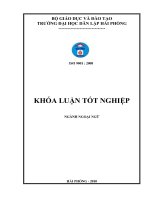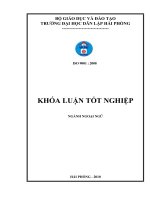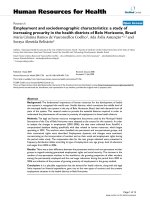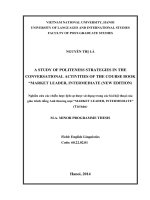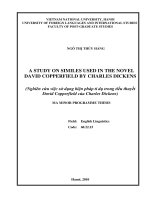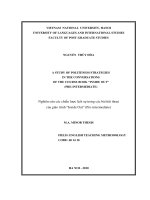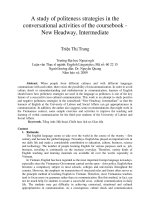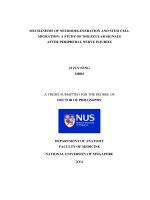A study of conditional sentences in the novel jane eyre by charlotte bronte and their vietnamese equivalents
Bạn đang xem bản rút gọn của tài liệu. Xem và tải ngay bản đầy đủ của tài liệu tại đây (796.24 KB, 129 trang )
MINISTRY OF EDUCATION AND TRAINING
HANOI OPEN UNIVERSITY
HÀ THỊ PHƯƠNG THÚY
A STUDY OF CONDITIONAL SENTENCES IN THE NOVEL
“JANE EYRE” BY CHARLOTTE BRONTE AND THEIR
VIETNAMESE EQUIVALENTS
(NGHIÊN CỨU CÂU ĐIỀU KIỆN TRONG TÁC PHẨM VĂN HỌC “JANE EYRE” CỦA NHÀ
VĂN CHARLOTTE VÀ TƯƠNG ĐƯƠNG TIẾNG VIỆT)
M.A. THESIS
Field: English Language
Code: 60220201
Hanoi, 2015
MINISTRY OF EDUCATION AND TRAINING
HANOI OPEN UNIVERSITY
HÀ THỊ PHƯƠNG THÚY
A STUDY OF CONDITIONAL SENTENCES IN THE NOVEL
“JANE EYRE” BY CHARLOTTE BRONTE AND THEIR
VIETNAMESE EQUIVALENTS
(NGHIÊN CỨU CÂU ĐIỀU KIỆN TRONG TÁC PHẨM VĂN HỌC “JANE EYRE” CỦA NHÀ
VĂN CHARLOTTE VÀ TƯƠNG ĐƯƠNG TIẾNG VIỆT)
M.A. THESIS
Field: English Language
Code: 60220201
Supervisor: Dr. Dang Ngoc Huong
Hanoi, 2015
CERTIFICATE OF ORIGINALITY
I, the undersigned, hereby certify my authority of the study project report entitled A study of
conditional sentences in the novel “Jane Eyre” by Charlotte Bronte and their Vietnamese
equivalents submitted in partial fulfillment of the requirements for the degree of Master in
English Language. Except where the reference is indicated, no other person’s work has been used
without due acknowledgement in the text of the thesis.
Hanoi, 2015
Ha Thi Phuong Thuy
Approved by
SUPERVISOR
Dr. Dang Ngoc Huong
Date:……………………
i
ACKNOWLEDGEMENTS
A piece of work of this magnitude is never the effort of only an
individual. Surely, this dissertation could not be either begun or
completed without the help, inspiration and moral support of many
people. I would like to thank them all here.
This work owes its existence to my supervisor Dr. Dang Ngoc
Huong who opened my eyes to the complexity of conditionals. From him
I have learned more than I could have ever done the work alone. He read
through my work and gave advice and made comments that provided
justification for my work. His guidance and positive criticism helped to
give shape to this work. I am grateful to him.
My thanks also go to all lecturers of the Faculty of Graduated Studies,
Hanoi Open University who taught me valuable lessons.
I would like to thank my beloved family members who inspired,
encouraged and fully supported me. Without their love and dedication, this
academic work would not be translated into reality.
Last but not least, I would like to gratefully acknowledge support and
encouragement of my classmates and friends who willingly helped me to
accomplish this thesis in many aspects.
ii
ABSTRACT
This thesis discusses about the English conditional sentences in the
novel” Jane Eyre” by Charlotte Bronte. The research is conducted to
examine the structures and usage of conditional sentences in English, find
out all kinds of conditional sentences being employed in this novel and its
Vietnamese equivalents, then discuss as well as suggest some implications
related to translating English conditional sentences to Vietnamese teachers
and learners.
The research is the mixed of qualitative and quantitative approaches
The source of data is the novel “Jane Eyre” by Charlotte Bronte. The main
data are conditional sentences in the novel. To support the main data, the
research is supported by other data taken from internet and grammar books
about conditional sentences. In order to attain the purpose, the data is
analyzed through descriptive and contrastive methods.
We have studied the basic types and most common forms of 291
conditional sentences in the novel, which prove to have a complex
constitution, a wide variety of forms, exceptions and functions.
Semantically, the most frequent type is the second one which serve the fact
that this novel in its state refers to a double faced essence - the reality and
fiction. There are 148 sentences identified 51 per cent of past modal verbs
could, should, might, would according to the requested domain of sentences.
Pragmatically, conditional sentences are also used to express threatening,
advising, warning, criticizing, requesting, suggesting and regretting.
There are some implications have been listed to help Vietnamese
teachers and learners of English overcome the difficulties in using and
translating English conditional sentences.
iii
LIST OF TABLES AND FIGURES
Chart 2.1: Classification of Mood ..................................................................13
Chart 2.2: Classification of Tense ..................................................................16
Chart 4.1: Classification of zero conditional sentences..................................40
Chart 4.2: The frequency of basic types of conditional sentences in the novel52
Chart 4.3: The appearance of modal verbs can, could, shall, may in
conditional sentences ......................................................................................55
Chart 4.4: The appearance of modal verbs must, should, might in conditional
sentences .........................................................................................................55
Table 2.1: The Zero conditional with the same tense in both clauses..........18
Table 2.2: The First conditional sentences (also called type 1)...................19
Table 2.3: The Second conditional sentences (also called type 2) ..............19
Table 2.4: The Third conditional sentences (also called type 3) .................20
Table 2.5: Types of English Conditional Sentences and their basic syntactic
features ............................................................................................................22
Table 2.6: Types of Mixed English Conditional Sentences ...........................22
Table 4.1: The summary of the ways of translating English conditional
sentences based on pragmatic functions .........................................................61
iv
TABLE OF CONTENTS
Certificate of originality................................................................................... i
Acknowledgements......................................................................................... ii
Abstract .......................................................................................................... iii
List of tables and figures................................................................................ iv
Definition of key technical terms ................................................................... v
Chapter I. INTRODUCTION
1.1 Rationale for the research ..................................................................... 4
1.2 Aims of the research ............................................................................. 5
1.3 Objectives of the research..................................................................... 5
1.4 Scope of the research ............................................................................ 5
1.5 Significance of the research.................................................................. 6
1.6 Structural organization of the thesis ..................................................... 6
Chapter II. LITERATURE REVIEW........................................................ 8
2.1 Review of previous studies.................................................................. 8
2.1.1 Previous researches overseas……………………….………….…8
2.1.2 Previous researches in Vietnam………………………………….9
2.2 Review of theoretical background ..................................................... 10
2.2.1 Mood ........................................................................................... 10
2.2.2 Tense ........................................................................................... 13
2.2.3 The English conditional sentences ............................................. 16
2.3 Summary of the chapter..................................................................... 30
1
CHAPTER III: METHODOLOGY.......................................................... 29
3.1 Research-governing orientations ....................................................... 29
3.1.1 Research questions...................................................................... 29
3.1.2 Research setting .......................................................................... 29
3.1.3 Research approaches................................................................... 30
3.1.4 Principles for intended data collection and data analysis.......... .31
3.2 Research methods .............................................................................. 31
3.2.1 Major methods vs. supporting methods...................................... 31
3.2.2 Data collection techniques.......................................................... 32
3.2.3 Data analysis techniques............................................................. 33
3.3 Summary of the chapter...................................................................... 34
CHAPTER IV: FINDINGS AND DISCUSSIONS .................................. 36
4.1 The forms of conditional sentences in the novel and its Vietnamese
equivalents ................................................................................................ 37
4.1.1 The basic types of conditional sentences in the novel and its
Vietnamese equivalents ............................................................................ 38
4.1.1.1 The zero conditional sentences ............................................... 38
4.1.1.2 The first conditional sentences ................................................ 40
4.1.1.3 The second conditional sentences ............................................ 43
4.1.1.4 The third conditional sentences ............................................... 48
4.1.1.5 The mixed conditional sentences.............................................. 50
4.1.2 The features of modal verbs in conditional sentences used in the
novel ………............................................................................................. 52
2
4.2 The pragmatic functions of conditional sentences in the novel and its
Vietnamese equivalent…………………………………………………...56
4.3 Implications for translating conditional sentences in the novel ......... 62
4.3.1 Some mistakes that learners often have in using English
conditional sentences in the novel.…………………………………62
4.3.2 The ways to help learners overcome difficulties in translating
English conditional sentences in the novel….…………………..……62
4.4 Summary of the chapter...................................................................... 65
CHAPTER V: CONCLUSION ................................................................. 67
5.1 Recapitulation .................................................................................... 67
5.2 Concluding remarks........................................................................... 67
5.3 Limitations of the current research .................................................... 68
5.4 Recommendations for further research.............................................. 69
REFERENCES............................................................................................ 70
APPENDICES ............................................................................................. 74
3
CHAPTER I: INTRODUCTION
1. 1 Rationale
English is deemed to be the only language that truly links the whole
world together. Without English, the whole world may not be as united as it
is today. It is widely used in every field of life such as science, technology,
foreign trade, tourism, business, education and so on. In Vietnam, there is
now a great demand to learn English for the process of integrating into
regional and international economic and diplomatic development. Moreover,
English enables us to communicate with people from different countries and
understand more about their traditions and cultures. However, it is not easy
to learn English as the second language for Vietnamese because there are a
lot of differences between the two languages and grammar is the typical
problem for this.
In terms of English grammar, from the author’s point of view,
conditional sentences are considered one of the most difficult issues for
nonnative speakers of English. English conditional structure plays an
important part in English Grammar and mastering it contributes greatly to
the students’ English performance. English conditionals require coordination
of verb forms in both the “ if” and the result clauses and the fact that verb
forms often do not retain their normal temporal meaning makes it even more
complex. Although the various conditional forms might seem quite abstract
at first, they are actually some of the most useful structures in English and
are commonly included in daily conversations.
4
For the above reasons, the main aim of this paper is to examine the
structures and usage of conditional sentences in English and Vietnamese in
the novel “Jane Eyre” by Charlotte Bronte. The author will find out all kinds
of conditional sentences being employed in this novel and its Vietnamese
equivalents and then discuss as well as suggest some implications related to
translating English conditional sentences to Vietnamese learners. The writer
hopes this will be a useful references for both teachers of English and
learners.
1. 2 Aims of the research
The study is expected to offer an overview of English conditional
sentences by means of descriptive and contrastive methods through the novel
“Jane Eyre” and then to provide Vietnamese learners with the deeper
understanding of English conditional sentences and some ways to help them
overcome the difficulties in translating them.
1. 3 Objectives of the research
In order to achieve the aims, the author has set a number of objectives
to be accomplished during the process of conducting this study:
- Firstly, identifying types of conditional sentences employed in the
novel "Jane Eyre" and their Vietnamese equivalents.
- Secondly, pointing out the pragmatic functions of conditional
sentences used in the novel and its Vietnamese equivalents.
-
And lastly, suggesting some implications for translating English
conditional sentences used in the novel.
1. 4 Scope of the research
Due to the limited amount of time, reference source and capability, the
author mainly focuses only on “If” conditional sentences in the novel “Jane
5
Eyre” by Charlotte Bronte. The study describes and analyzes the structures
and usage of natural language conditional sentences in the novel, then brings
out some suggestions to help those interested to avoid possible deplorable
mistakes in translating this particular kind of sentence structure.
1. 5 Significance of research
This paper focuses on describing and analyzing the structures and
usage of English conditional sentences described in grammatical books, then
examining the usage of them in different communication circumstances in
the novel “Jane Eyre”. Besides, the paper will also find out the frequency of
conditional sentences in the novel "Jane Eyre" to hypothesize the presence of
these conditional sentences and its Vietnamese equivalents. Last but not
least, the paper suggests some implications for translating English
conditional sentences.
1. 6 Structure of Thesis
Chapter I: Introduction
Provides rationale of the study, research problems, aims and objectives
of the research, the significance of the study and the scope of the research.
Chapter II: Literature Review
Summarizes, synthesizes and reviews critical points of relevant
published works. Concepts that are mentioned in the theoretical background
of interpreting include: overview of mood, tense and English conditional
sentences.
Chapter III: Methodology
Explains what methods are employed for data collection and analysis,
looks at the selection of subjects and the procedures of data collection and
analysis.
6
Chapter IV: Findings and discussions
Finds out the basic types and most common forms of conditional
sentences that appeare in the novel as well as their pragmatic functions, the
frequency of conditional sentences and its Vietnamese equivalents. Then,
lists out the current mistakes of using conditional sentences and suggests
some implications for translating English conditional sentences.
Chapter V: Conclusion
Summarizes the main features of conditional sentences in answer to
the three research questions, condenses the limitations, proposes some
suggestions for further studies.
7
CHAPTER II: LITERATURE REVIEW
2.1 Review of previous studies
2.1.1 Previous researches overseas
From functional grammar point of view, through investigating some
projects such as A Practical English Grammar (A.J.Thomson, A.V.Martinet,
1986), English Grammar in Use (Raymond Murphy, 1994), Advanced
English Practice (B.D Graver, 1986), Understanding and Using English
Grammar (Betty Schrampfer Azar, 1998) và Oxford Guide to English
Grammar (John Eastwood, 1997), we realized that conditional sentences
were put into different types based on two criterions: physicalism (real,
unreal) and time (past, future, present). There are three basic types:
Type 1 – open conditional sentences and real conditional sentences
Type 2 – unreal conditional sentences and hypothetical condition
Type 3 – unreal condition in the past
Moreover, B.D Graver and John Eastwood also added type 0 in order
to indicate condition – consequence. Meanwhile, A.V.Martinet and Betty
Schrampfer Azar put it into type 1 as the automatic consequences, habit and
truth. In addition, A.V.Martinet, Betty Schrampfer Azar and John Eastwood
talked about mix type such as 1-3, 2-3, 3-2.
In universal grammar, the linguisticians such as Fillmore (1986),
Langacker (1987), Sweetser have applied prototype theory on linguistic
analyses. Eve Sweetser, in From Etymology to Pragmatics (1990) classified
conditional semantics according to the three domains she speaks of in that
book, the content domain, the epistemic domain, and the speech act domain.
8
Content-based conditionals are understood by relating the content of the two
clauses to each other. A typical way in which content conditionals can be
understood is for the "P" clause to identify a situation which causes or
automatically results in the state of affairs signaled by the "Q" clause.
Grammar books agree that there are three or four main types of
conditional clauses. Quirk et al (A Comprehensive Grammar of the English
Language) distinguished four main types such as the Zero (Cause and
Effect) Conditional, the First (Open) Conditional, the Second (Unreal)
Conditional and the Third Conditional.
2.1.2 Previous researches in Vietnam
Dang Thi Huong (Practical English Grammar,1998) approached the
conditions from the view of two separation clauses and Mood categories.
Specifically, the authors suggested that the IF clause was divided into two
categories, depending on the speaker's conception, the indicative and
Subjunctive (based on the correlation of tense and time); the main clause
included Infinitive and Modal and would be changed if it referred to the past,
present or future. This system came from the perspective of theory and
conditional problem was solved flexibly. However, when applied in practice,
this approach is obviously difficult for the readers who are not English
majors.
Võ Thị Kim Anh (Different Ways to Express Condition and
Concession in English and Vietnamese - M.A thesis,2010) stated that
condition-consequence relation is often described as “If P then Q”. Her
article just focused on condition-consequence expressed by subordinating
conjunctions. Pragmatic functions of conditional sentences concerning
9
illocutionary act in English and Vietnamese: threatening, advising, warning,
criticizing, offering, requesting, regretting, and softening are discussed.
In short, there have been various studies on conditional sentences in
general from an article, a scientific research to a graduation paper or a book.
However, all the authors only focus on the types and meanings, there’s
hardly any research into conditional sentences in a novel. For this reason, our
research is an endeavor to examine the problem of conditional sentences in
English grammar and novels.
2.2 Review of theoretical background
2.2.1 Mood
2.2.1.1 Concept of Mood
Some authors have mentioned the concept of mood in their book.
According to E.M.Gordon and I.P.Krylova: “Mood is the form of the
which shows the relation between the action expressed by the predicate verb
and reality”.
This relation is established by the speaker who may wish to present an
action as a real fact or as a command (a request) or as something unreal,
something that does not exist in reality.
V. Vinogradov also expressed the same idea in another way: “Mood
expresses the relation of the action to reality as stated by the speaker”.
2.2.3.2 Types of Mood
There have been a lot of opinions about the difficult types of mood but
the most common view is that in modern English there are three moods:
Indicative , Imperative mood and Subjunctive mood.
a) Indicative Mood
10
According to llyish (1971), the use of the Indicative Mood shows that
the speakers (or writers) present the action or real. Most of what we have
said is in the indicative mood, most of what anyone says or writes is in the
indicative mood. So, this is the most common mood used in any language.
We can use indicative mood to give information (I like reading poetry, we
had dinner at six…), to express opinions (I think she is a good student,…) to
make promises (I shall do everything I can help you,…)
b) Imperative Mood
The imperative Mood is the plain stem of the verb. It may be used in
the affirmative (Sit down!) and in the negative form (Don’t go out!, Don’t be
a fool!) If we want to make a command or request more expressive, we use
the emphatic form (Do listen to him! Do be quiet!...) We have the following
different kinds of command:
- Command without a subject (Open the door!)
- Command with a subject (Don’t you worry! or Somebody clean the
board!)
- Command with “let” (Let me take your coat! or Let’s go outside!)
Thus, in English, the imperative verb is severely restricted in tense, aspect,
voice and modality
c) Subjunctive Mood
In contrast to the Indicative mood, the Subjunctive usually refers to
nonfactual or hypothetical situations.
There are two types of subjective - the present Subjunctive and the
past Subjunctive.
+ The present Subjunctive:
11
The present Subjunctive of all verbs is identical with the simple
present tense indicative, except that the third person singular form is the
same as in all other persons (for example: without the “s” ending). The
present Subjunctive form of “to be” is “be” for all persons.
Example: It is necessary that they be told what happened.
In the sentence above, the dependent clause (that…) contains an order;
therefore, the mood should be Subjunctive. Therefore, the verb should be be
told rather than are told.
+ The past Subjunctive:
The past Subjunctive in English consist of the past Subjunctive which
is identical with the simple past tense indicative, except that the verb “to be”
has “were” for all persons and the past perfect Subjunctive which is identical
in form with the past perfect indicative. The past Subjunctive is used in
conditional clauses implying a negative, or in clause in which the condition
is combined with improbability or unreality.
Examples:
If I were you I should accept the offer.
If I had worked harder, I wouldn’t have failed the exam.
Futhermore, the past subjunctive is also used after such expressions
as:
- I wish that… ( I wish he visited us more often)
- Suppose that…(Suppose (that) the teacher caught us wasting time)
Summary
12
Indicative mood
Imperative Mood
Mood
The present
Subjunctive
Subjunctive Mood
The past
subjunctive
Chart 2.1: Classification of Mood
2.2.2 Tense
2.2.2.1 Concept of tense
Tense has been defined by many linguists. For instance, Hockett(
1967:235) states that tense is a grammatical category that is used to show
different locations of an event in time. Lyons( 1968:149) adds that tense
has to do with time relations as expressed by systematic grammatical
contrasts. Crystal( 1985: 352) postulates that tense is a category used in the
grammatical description of verb referring primarily to the way the grammar
marks the time at which the action denoted by the verb took place.
Finally, Comrie( 1986: 26) gives a wider scope to the definition of tense,
regarding it as the grammaticalization of location in time. Considering the
comprehensive quality of Comrie's definition, the researcher believes that
it is the most appropriate among all the other definitions.
13
2.2.2.2
Types of tense
a) Present tenses
Comrie (1988:37) states that the present moment is a location fixed in
the time line. Thus, the present tense is the location of the situation at that
point. Yet, this seems somehow a controversial argument since
situations that coincide with the present moment are rare. However, such
rare situations do occur. Comrie gives an example with a performative
verb: I promise to pay you ten pounds.
Comrie (Ibid.: 38) adds that one of the most interesting characteristics
of the present tense is that it can be used to refer to situations that occupy a
much longer period of time than the present moment, including the present
moment.
Example: The Eiffel Tower stands in Paris.
b) Past tenses
The past tense is used when the happening state, action or event
is related to a definite time in the past, a point that may be called ' then '.The
past tense is the marked member of the opposition past/ present, as Fowler
(1974:42) suggests that tense in English has only two values from a formal
point of view, i.e., [ ± past ] avoiding the use of ' present ' in tense
opposition. A sentence is either marked ( + past ) or unmarked ( - past ).
c) Futurity
Traditional grammarians divide time into threefold opposition, i.e.,
past, present and future, while structuralists, being more committed to
form than to meaning, reject the term ' future tense ' because there is no verb
form that can denote future time like the two forms representing past/ present
respectively.
14
Stone (1976:36) states that simple futurity denotes an action with
reference to future time or future intention. It is distinguished by means of
two main markers, viz. shall and will whose function is either to give the
meaning of pure futurity or to express determination or promise. The
problem arises, according to Hornby (1977:45) in indicating future
activities aside from other notions like likelihood , willingness, and so
on.
Yet, one can assume that when future events are not inflected by
these notions, i.e., likelihood and the like, we are talking about “pure future”.
The objections that have been raised against dealing with a “future tense” is
treated by Daoud (1988:1) who considers tense as a semantic category
whose main function is to express the concept of time in its three
dimensions, i.e.,
past, present and future. Taking this definition into
consideration, Daoud (Ibid.) argues that “future tense” should be treated as
an integral part of the English tense-system though most linguists reject the
use of “future tense” since the inflectional morphology of the English verb
does not include any affix that could be regarded as an explicit marker of
future tense.
Summary of tense
15
Present tenses
Past tenses
Tense
Futurity
Chart 2.2: Classification of tense
2.2.3 The English conditional sentences
2.2.3.1 Definition of conditional sentences
Randolph Quirk in “university grammar of English” (1972) suggested
an idea: “Conditional clauses state the dependence of one circumstance or
set of circumstances on another”.
Collin Cobuilt (1990) in “English grammar” also pointed out:
“Sentences containing conditional clauses are sometimes called conditional
sentences” and as for him conditional clauses begin with “if” or with
conjunctions having similar meaning like “unless”.
From the definition above we can define the Conditional Sentence as
one kind of complex sentence of at least two main clauses “the main clause
(result clause)” and “subordinate clause (if clause)” used to express the
dependence of one circumstance or set of circumstances on another and in
most of cases two clause orderings are acceptable. In others words the “If
16
clause” sets up the condition for “the main clause” to produce the result or
outcome.
2.2.3.2
Different classifications of conditional clauses
This section deals with various types of conditionals clauses that
exist in English. The mood of the verb is the key element in identifying the
type of condition, certain constructions are fairly standard. The verb
forms are a salient feature in the description of conditionals and later the
classification. The classification of the types of conditionals identified
as shown subsequently is dependent on the various verb forms used in
both the protasis (antecedent) and the apodosis (consequent). The
identification, classification and discussion done in this study is in
conformity with most grammarians on conditionals such as (Young,
1989), Goodwin cited in (Fintel, 2012), and whose classification of
conditional sentences is based on the verb in the protasis, Robertson also
cited in (Fintel, 2012) whose classification basically follows that of
Gildersleeve in classical Greek by identifying four types of conditionals,
each determined by the mood of the protasis. Depending on which book of
grammar one consults, one will find three, four or more English
conditional sentence types referred to (and with slightly different names
for each), but generally, one can say that there are four that are most
recognized. These are the zero conditional, the first conditional, the
second conditional, the third conditional and the mix conditional.
a) The zero conditional sentences
The zero conditional is a structure that expresses that something is
(or was) always true, that one action is (or was) always followed by
another. It is also used to talk about scientific facts - things which always
17
happen under certain conditions. It is worth pointing out that most zero
conditional sentences will mean the same thing if “when” is used instead
of the “if”. In the zero conditional therefore, the Present Simple Tense or
the past is used in both clauses. The Zero conditional is called Zero
because it is not about what might, or will, happen in the future, or about
hypothetical or unreal situations, but about things that always happen
when something else is done. The result or the consequence is always true
or certainty.
Form
If- clause Time ref of MainIf-clause
clause
Semantic Function
If+ [pre]
Now/always [Present]
Time ref of Hypotheticality Temporality
Mainclause
Now/always Real, possible
Time-less
If+ [pre]
Present
[pre cont]
Present
If+ [pas]
Past
[past]
Past
If
generic
you expose a candle to it melts.
excessive heat,
it means that he is very angry.
Peter is cursing,
she just stared into
the
Mary was sad,
distance.
Table 2.1: The Zero conditional sentences with the same tense in both clauses.
b) The first conditional sentences: real possibility
The first conditional sentence (also called conditional type 1) is a
structure used for talking about possibilities in the present or in the future.
In other words, it is possible and also very likely that the condition will be
fulfilled. Table 2.2 describes how this is realised.
18
Form
If-clause
Time ref of Main
If-clause
clause
If+ [pre]
Pres/future
If
[Pre modal]
Will/must/
can/may
Semantic Function
Time ref
of Main
clause
Pre/ future
it rains
Hypotheticality Temporalit
y
Real, possible
& probable
Pre/future
time
bound:
I will stay at homeexplicit
Table 2.2: The First conditional sentences (also called type 1)
c) The second conditional sentences: unreal possibility or dream
The Second Conditional (also called conditional type 2) is a
structure used to talk about unreal situations in the present or in the
future. It is used to talk about impossible situations. Table (3) shows how
this type of conditional is realised.
Form
Semantic Function
If-clause
Time ref
of clause
If+ past
Now
Main clause Time ref
of Main
clause
[Past, model] Now or
or any
time
would/should/ any time
could/might
If
I won the lottery
Hypotheticality Temporality
Unreal
Present
Hypothetical
conditional with
probable
I would buy a car
Table 2.3: The Second conditional sentences (also called type 2).
d) The third conditional sentences: no possibility
The Third Conditional Sentences (also called conditional type 3) is a
structure used for talking about unreal situations in the past. In other
words, it is used to talk about things which DID NOT HAPPEN in the
past. The action in the third conditional is characterized by impossibility
19
